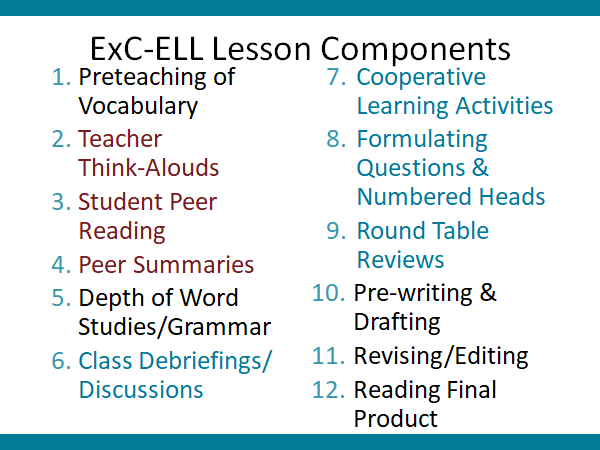Research on the Bilingual Cooperative Integrated Reading and Composition and Expediting Comprehension for English Language Learners
Margarita Calderón
High-quality program for English learners/Multilingual learners can be implemented in a variety of contexts when it is carefully crafted and based on empirical evidence as with these two models.
The Theoretical and Research Base
National researchers’ panels have been convened in the past twenty years to review the literature on bilingual education and English language learners (recently called emergent bilingual or multilingual students). These reviews focused on the development of language and literacy.
Some of the major syntheses of research have published their results and produced guidelines for the field. Dr. Calderón has participated in panels 1, 2, 4, and 5 listed below.
- Synthesis of research from the National Literacy Panel on Language-Minority Children and Youth (August & Shanahan (Eds)., 2006).
- Developing reading and writing in second language learners. Lessons from the Report of the National Literacy Panel on Language-Minority Children and Youth (August & Shanahan, 2008).
- Synthesis of research from the National Academies of Science entitled Promoting the Educational Success of Children and Youth Learning English: Promising Futures (2017).
- Synthesis of research compendium on teaching vocabulary entitled Research and Development on Vocabulary (Hiebert & Kamil, (Eds.) 2005).
- Reviews have also been conducted under the auspices of educational centers or universities (Slavin & Cheung, 2005; Genesee, Lindholm-Leary, Saunders, & Christian, 2006; Lindholm-Leary & Genesee, 2010), and resources such as the Guiding Principles for Dual Language Education for effective program design and evaluation (Howard, E. et al., 2018 third edition),
- Independent reviews have been conducted by Thomas and Collier, 1997; Escamilla and colleagues, 2021) and those mentioned in other chapters in this book.
These reviews of the literature have served to develop two empirical and descriptive studies to validate the research panels’ findings.
The Development and Testing of the Instructional Models
BCIRC
A five-year experimental study by Calderón, Hertz-Lazarowitz, & Slavin (1998) evaluated a reading program called Bilingual Cooperative Integrated Reading and Composition (BCIRC). Participants were 222 Hispanic children in the Ysleta Independent School District in El Paso, Texas. Seven of the highest-poverty schools with dual language programs in the district were assigned to experimental (3 schools) or control (2 schools) conditions. The experimental and control groups were well matched on pretest and demographics. Analyses of covariance controlling for Bilingual Syntax Measure scores found significantly higher scores for students in BCIRC classes with a median effect size of +0.54. This study qualified to be included into the U.S.D.O.E. What Works Clearinghouse. No other programs currently in use qualify for the WWC or are showing no or negative effects on MLs.
EXC-ELL
A five-year study in middle and high schools was commissioned by the Carnegie Corporation of New York to focus on core content instruction in secondary schools with high multilingual student populations in four experimental middle and high schools and four comparison schools in Kauai, Hawaii and in Washington Heights, New York City. All core content teachers in the experimental schools participated in whole school professional development workshops and coaching. An adaptation of BCIRC for integrating language and literacy into math, science, social studies, and language arts became Expediting Comprehension for English Language Learners (ExC-ELL). In addition to the overall effect sizes (+0.36 to +0.42), the ExC-ELL schools were originally identified as low-performing became the highest performing schools in those districts in two years of implementation (Calderón, 2007). Results of these longitudinal studies have been replicated and their positive effects have sustained in the past ten years where the whole school was involved and not just a few designated teachers (Calderón & Minaya Rowe, 2011; Calderón and Tartaglia, 2023).
These experimental and quasi-experimental studies generated evidence-based instructional strategies. These studies demonstrated that a whole-school approach serves to move everyone in the same direction and grow a positive mindset toward biliteracy in elementary grades and in all subject areas in secondary schools.
Implications for Implementation
A quality program begins with the following components of a comprehensive instructional and professional development program and the follow-up transfer into the classroom of those components:

For references, see list of Dr. Calderón’s publications.